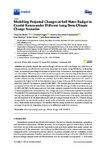Modelling Projected Changes in Soil Water Budget in Coastal Kenya under Different Long-Term Climate Change Scenarios

View/
Date
2020-09-01Author
Were, Cornelius
Greggio, Nicolas
Giambastiani, Beatrice Maria Sole
Wambiji, Nina
Nzeve, Julius
Antonellini, Marco
Metadata
Show full item recordAbstract
The possible impacts that climate change will have on soil water budget and specifically on
deep percolation, runoff and soil water content have been investigated using HYDRUS, a methodology
based on numerical modelling simulations of vertical water movement in a homogenous soil column
on a flat surface. This study was carried out on four typical soil types occurring on the Kenyan coast
and the adjacent hinterlands of up to an elevation of 200 m above sea level (m a.s.l.) covered by five
weather stations (two dry and three wet stations). Results show that deep percolation and runoff are
expected to be higher in 2100 for both Relative Concentration Pathways (RCPs) 2.6 and 8.5 scenarios
than they were for the reference period (1986–2005). The average deep percolation is expected to
increase by 14% for RCP 2.6 and 10% for the RCP 8.5, while the average runoff is expected to increase
by 188% and 284% for the same scenarios. Soil water content is expected to either increase marginally
or reduce depend in the same scenarios. The average soil water content is also expected to increase by
1% in the RCP 2.6 scenario and to decrease by 2% in the RCP 8.5 scenario. Increase in deep percolation
through clay soil is expected to be the largest (29% in both scenarios), while sandy and sandy clay
soil are expected to be the least influenced with an average increase of only 2%. Climate change
is expected to impact runoff mostly in sandy soils, whereas the least affected would be clay loam
soils. These results further support the assertion that the change in climate is expected to impact the
recharge of aquifers by triggering an increase in infiltration under both scenarios.
